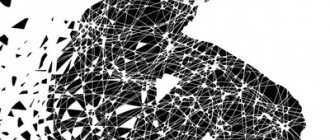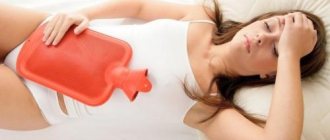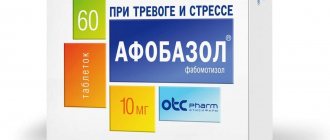What are panic attacks?
Attacks are more likely to be features of the nervous system than a pathology. During a panic attack, women experience a stress factor, only the sensations from it intensify significantly. An attack triggers a series of reactions in the body, during which the patient feels the symptoms of an attack.
- As you know, under the influence of stress, adrenaline and cortisol are produced in increased mode, which can cause vasoconstriction and increase the heart rate. Such changes are provoked by a sharp rise in blood pressure.
- When a person’s breathing increases, a significant amount of carbon dioxide is evacuated from the body, against the background of which the blood changes its acidic characteristics. This further increases anxiety, provokes dizziness, and a feeling of numbness in the limbs.
- Most of all, vascular spasm affects peripheral tissues. Muscles, skin, and subcutaneous fat suffer from lack of nutrition - in a stressful situation they begin to produce lactic acids. When they enter the blood, the external manifestations of the attack intensify, which is why the body must mobilize blood circulation, providing the brain and heart with the required volume.
- The duration of panic attacks is from several minutes to half an hour. Such attacks are not isolated - usually panic attacks are repeated again.
Prevention
Prevention of panic attacks during menopause is achieved taking into account the following recommendations:
- You need to get good sleep, set aside at least 8 hours for rest, and go to bed before midnight.
- Do not consume alcoholic beverages, tobacco products and other psychotropic drugs.
- Do not expose yourself to nerve irritants.
- Stabilize your rest and work schedule. This eliminates tension.
- Perform simple physical exercises or breathing exercises. Such loads allow you to tone the nervous system.
- Improve your diet, eat less fatty foods, more fruits and vegetables, drink a lot of water.
Sources:
https://vklimakse.ru/panicheskie-ataki-simptomy.html https://medmaniac.ru/trevozhnost-i-panicheskie-ataki-pri-klimakse/ https://nevrology.net/sindromy-i-zabolevaniya/vegetativnoj -nervnoj-sistemy/panicheskie-ataki/simptomy-i-lechenie-pri-klimakse.html
Manifestations of panic attacks during menopause
The mechanism of occurrence described above does not differ in women during menopause, but the process also includes the factor of deficiency of female sex hormones that can stabilize the psyche. And if panic attacks have not previously occurred, then with the onset of menopause, their symptoms begin to appear.
Women during menopause experience the following signs of panic attacks:
- feeling of fear;
- unreasonable anxiety against the background of external well-being;
- an attack of heat, felt most of all in the upper half of the body: on the face, neck, chest;
- sudden sweating, chills;
- headache;
- rapid heartbeat;
- sleep problems;
- nervousness.
If a panic attack occurs during menopause, the symptoms can sometimes be confused with other diseases, but the most important marker of a panic attack is the presence of causeless fear and an all-encompassing feeling of anxiety.
Treatment of such conditions must be carried out jointly with two doctors - a gynecologist and a psychologist. It is against the backdrop of effective treatment of gynecological problems that a psychologist will be able to help the patient get rid of panic attacks during menopause.
Causes
Menopause in the life of every girl is manifested by different changes in the body. This is a physiological process of transformation of the female reproductive system, during which involutional processes develop. The hormonal background is varied and ensures the normal functioning of the body, affects metabolism, strengthens vascular tone, stabilizes blood pressure, and controls the functioning of the nervous system.
Thanks to this phenomenon, the female nervous system is characterized by lability. Hormonal disruptions can transform nervous regulation. Therefore, together with disorders of menstrual function during menopause, the work of the psyche is destabilized. Problems with nervous activity arise due to awareness of the fact of aging. This is why panic attacks often occur.
Risk factors
Note that panic attacks do not affect all women during menopause. Statistics show that about fifteen percent of the fair sex who have crossed the fifty-year mark and entered menopause suffer from them. Why do other women manage to avoid the problem, and what can provoke it?
It is worth mentioning diseases that are directly related to the mechanism of development of such conditions. It is in the presence of the following diseases that panic attacks are more severe:
- migraine;
- pathologies of the adrenal glands;
- thyroid diseases;
- emphysema;
- pathologies of the cardiovascular system;
- predisposition to allergic reactions.
Of course, the most aggravating circumstance is the panic attacks that were present in a woman’s life before menopause. This means that during menopause, panic attacks will be more difficult for those who were previously diagnosed with them.
A panic attack suffered at least once creates an unfavorable condition for a woman, which manifests itself in the following:
- the patient is in constant tension from exertion and stress;
- possible alcohol and tobacco abuse;
- incontinence of emotions, frequent breakdowns;
- lack of normal sleep and rest.
Sometimes panic attacks are aggravated due to the influence of an external factor on a woman’s life: they can occur due to injuries, accidents, or being in an unusual situation. Against the background of factors predisposing to panic attacks, these features of a woman’s life during menopause only worsen her condition.
Therefore, the task of the doctor treating the patient is not only to eliminate the acts of panic attacks themselves, but also to prevent their occurrence again. Otherwise, without treatment, a woman becomes a target for diseases such as depression, phobia, and schizophrenic disorders.
If before menopause a woman had obsessive-compulsive disorders (OCD), then menopause aggravates the course of these processes. Panics associated with OCD, intensified by menopausal changes in the body, can lead to serious mental disorders. Therefore, this category of patients requires special monitoring and control of their behavior. In this case, hormonal therapy prescribed by a gynecologist will not be able to give the desired effect, so consultation with a psychiatrist and the necessary treatment are required.
Traditional methods of treatment
In folk medicine there are many recipes that help get rid of panic attacks.
The most popular include the following:
- Every morning prepare an infusion of 2 tbsp. lie dry peppermint and 1 liter of boiling water. When the infusion has cooled, strain. Drink a glass of infusion when you feel an approaching attack, and also when going to bed.
- Twice a day, half an hour before meals, drink a mixture of 40 ml of freshly squeezed red beet juice and the same amount of honey.
Treatment is carried out for 2 weeks, then a break is taken for a similar period and, if necessary, the course is repeated.
Types of Panic Attacks
Panic attacks can occur both physiologically and psychologically. Most often, it can be difficult to separate these manifestations of a panic attack, since in each individual situation there is a different percentage of a combination of physical and mental.
Mental manifestations of attack
A panic attack occurs, first of all, in a woman’s mind. These manifestations can prevail over the physical ones, and have a more pronounced character: the woman feels a sense of impending danger, which in fact is not there. However, in her mind there is only the expectation of something negative that is about to happen to her. A woman cannot explain who or what she is afraid of. Moreover, it is impossible to dissuade her or try to explain that there is no negativity nearby. This idea, which arose in her mind, completely dominates the woman and is all-consuming at a certain moment.
Another type of consciousness disorder is fear of death. Unlike the feeling of danger, the fear of death is not so swift; it is not present here and now, but takes possession of a woman over a certain period of time (a week, a month, the last few days). The fear of death in some cases may weaken, but the unpleasant aftertaste that a woman may get sick and die remains. Thus, the problem itself does not go away, the degree of its intensity is only slightly reduced.
With psychological problems, women experience the following disorders:
- feeling of a lump in the throat that comes up at a moment of fear;
- fear of losing your mind;
- difficulties with a sense of reality – distortion of visual images, sound perception;
- depersonalization - the feeling that a woman is looking at herself from the outside, unable to control her actions;
- a state like before fainting, the appearance of lightheadedness, loss of reality.
During panic attacks, the fears are so strong that a woman can feel either complete paralysis, or, conversely, a desire to escape somewhere.
Physical manifestations of nervous instability
The second type of panic attacks is physical. Usually, in terms of the time of manifestation, they coincide with mental discomfort and are accompanied by the following sensations:
- increased heart rate associated with the release of dopamine and adrenaline into the blood;
- hot flashes or sudden chills associated with changes in vascular tone;
- increased breathing to compensate for the loss of oxygen;
- increased sweating associated with the need for thermoregulation and disruptions in the functioning of the autonomic nervous system;
- Also, during panic attacks, women may feel dry mouth, suffer from constipation, heartburn, and vomiting.
Signs of an attack may be similar to those of a stroke, asthma attack, or internal bleeding, so if panic attacks occur, these diagnoses must be excluded. Usually, after an attack, attacks during menopause are characterized by the disappearance of unpleasant symptoms, while in other diseases the unpleasant symptoms continue to operate.
How does the condition manifest?
Doctors conditionally divide the symptoms of an attack into 2 components: physical, which the patient feels with her body, and mental, which is recorded by consciousness. During an attack, mental symptoms predominate, which are also pronounced.
Mental symptoms
Symptoms of the mental group include:
- There is a feeling of impending danger that does not actually exist. At the moment of an attack, the expectation of negativity begins to dominate over other thoughts in a woman’s mind. Therefore, it is simply impossible to explain that she is not in danger.
- The fear of death takes over. It develops over a period of time: several days, a week or a month. Then the feeling of fear subsides a little, but the problem remains. A woman is afraid of contracting a dangerous disease or other health-related phobias appear.
During menopause, fear can be so great that a woman wants to run away somewhere, or it completely fetters her.
Experiencing a feeling of fear, a woman faces the following disorders:
- there is a lump in the throat;
- perceives with distortion what he sees or hears in reality;
- it seems to her that she is looking at herself from the outside and cannot control her actions;
- begins to be afraid of going crazy.
- a pre-fainting state appears, a feeling of lightheadedness, loss of connection with reality.
If during the attack the described disorders did not manifest themselves clearly, then recurrence of attacks should be expected. After a panic attack with intense symptoms, attacks occur infrequently.
Physical symptoms of a panic attack
The following physical symptoms of an attack are identified, which occur due to the release of adrenaline into the blood:
- The heart begins to beat faster and it seems as if it will jump out of the chest.
- Changes in vascular tone provoke a fever attack.
- Breathing becomes very rapid. Thus, oxygen deficiency due to narrowed blood vessels is compensated.
- Dry mouth appears and sweat profusely occurs due to disturbances in the functioning of the autonomic nervous system.
- Chills begin with severe trembling.
- Weakness appears, accompanied by dizziness.
- The palms of the hands and soles of the feet become cold.
- There is a painful sensation in the chest on the left side.
- Diarrhea or vomiting may occur.
Pathology therapy
Treatment for a panic attack should be comprehensive. To normalize hormonal levels, a woman is prescribed hormone replacement therapy. Medicines must be taken strictly in prescribed doses so as not to provoke a deterioration in health.
If serious mental problems arise, it is recommended to consult a psychotherapist. However, such help is required only for those who had panic attacks before menopause. Most women are able to eliminate a panic attack on their own with simple tips:
- in case of breathing problems, you need to learn to breathe in your hands: firstly, it distracts from the main problem, and secondly, it helps to normalize breathing;
- It is better to perform breathing acts by counting;
- to distract from the state of panic, anxiety is driven away by switching to other ideas: you can count trees, cars passing by only a certain color, etc.;
- for some patients, a rubber band can be a salvation, with which you can lightly hit yourself on the wrist to relieve an attack and distract from negative thoughts;
- if you experience chest pain caused by cardiac problems, you can cough a little;
- If a panic attack occurs in women suffering from asthma or epilepsy, qualified help may be needed; you need to warn someone you know about this.
Panic attacks are an unpleasant phenomenon that must be treated. Such attacks do not go away on their own; the attending physician must know about their occurrence in order, if necessary, to schedule a consultation with another specialist and adjust the patient’s treatment.
Interesting and educational video on this topic:
About
First aid
You won't be able to cope with the seizure, but it is possible to reduce the symptoms. To do this, you need to follow these tips. To stabilize breathing, you need to breathe into a paper bag or clasped palms together. Breathing exercises are performed. Inhalations are performed while the abdomen expands. The exercise is performed in 3 stages. Inhale, hold, exhale, you need 15 approaches.
You will need a distraction from negative thoughts. When chills occur and limbs become numb, you can take a warm bath. When your chest hurts badly, you need to take painkillers.
Mental symptoms
Such symptoms are considered predominant because they are pronounced. The following symptoms may occur:
- Approaching danger.
- Fear of death, which after several attacks develops into a fear of contracting a disease, and then into other fears due to health conditions.
- Lump in the throat.
- Fear of losing your mind.
- Derealization, in which the perception of information from auditory and visual receptors is distorted, and what is happening seems to slow down.
- Depersonalization - the girl cannot control her actions and observes them as if from the outside.
- There is a pre-fainting state or a feeling of lightheadedness.
A person’s activity may be restrained or, on the contrary, in a panic, he will try to run somewhere or hide. During seizures, psychological symptoms are not the same.










